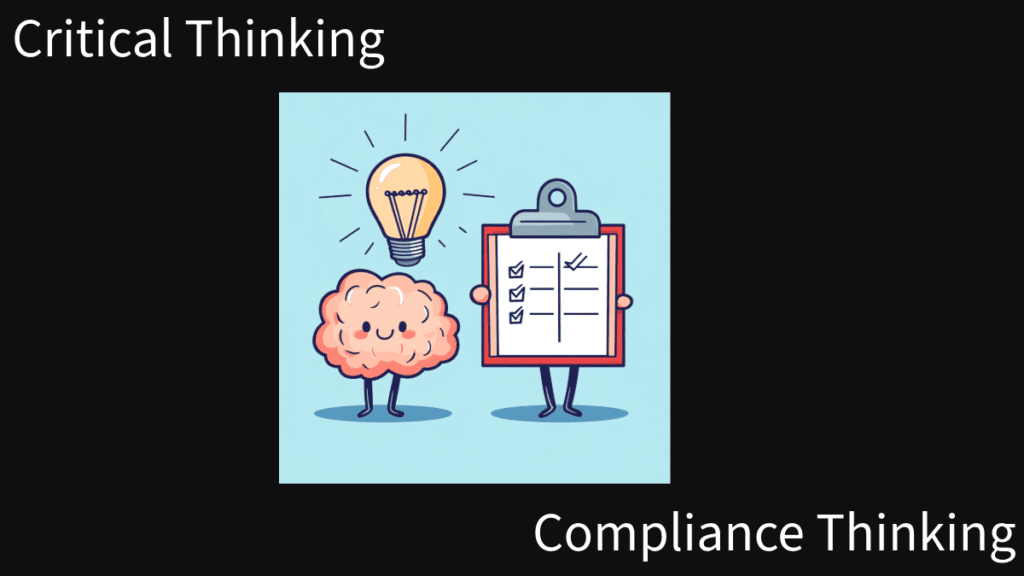Critical Thinking Over Compliance: Prioritizing Real-World Resilience
In today’s cybersecurity landscape, the reliance on rigid, checklist-based approaches is proving to be a critical vulnerability. Security professionals must shift from a mindset of mere compliance to one that emphasizes critical, adaptive thinking and real-world resilience thus establishing critical thinking over compliance mindset.

Beyond the Checklist: Critical Thinking in Compliance vs Real-World
The Compliance Trap of Critical Thinking:
Traditional security models often prioritize adherence to standards and regulations—think ISO 27001, NIST frameworks, or industry-specific mandates. While these checklists provide a useful baseline, they can create a false sense of security. Organizations may tick all the boxes without genuinely understanding or mitigating the underlying risks. The tendency to equate compliance with security has allowed sophisticated threats to exploit gaps that are overlooked in the rush to meet certification requirements.
Real-World Resilience of Problem-Solving:
True cybersecurity resilience is not built on paper compliance but on a deep understanding of an organization’s unique risk landscape. It requires security professionals to continually question and challenge the status quo, adapting defenses as new threats emerge. This means conducting realistic threat simulations, engaging in adversarial testing, and designing systems that assume breach rather than one that solely focuses on detection.
Cultivating Critical Thinking Skills:
Proactive Analysis:
Security teams need to move away from a reactive posture and embrace a proactive mindset. This involves constantly analyzing emerging threats, understanding attacker methodologies, and predicting potential vulnerabilities before they can be exploited. By fostering an environment that encourages curiosity and rigorous questioning, organizations can stay ahead of evolving risks.
Adaptive Learning:
In an era where cyber threats are dynamic and multifaceted, education must go beyond rote learning of compliance procedures. Continuous training programs should focus on enhancing critical thinking skills, teaching professionals how to assess risks contextually and make informed decisions in complex, fast-paced environments. This kind of adaptive learning enables teams to respond to real-world scenarios rather than merely following prescribed steps.
Cross-Disciplinary Collaboration:
Cybersecurity is no longer the domain of isolated IT departments. It demands collaboration across various fields—ranging from threat intelligence and behavioral analytics to policy-making and legal expertise. By breaking down silos and encouraging interdisciplinary dialogue, organizations can foster a culture where critical thinking is the norm, not the exception.
Real-World Impact:
From Theory to Practice:
Consider incidents such as the MOVEit mass exploitation or the OpenAI data leak. In both cases, rigid adherence to outdated protocols and a lack of adaptive thinking allowed vulnerabilities to be exploited. Had security professionals prioritized real-world resilience and been more willing to challenge existing models, these breaches might have been prevented or mitigated more effectively.
A Call for Change:
The need for critical thinking over simple compliance is a call to re-engineer the foundations of cybersecurity practices. It’s about building systems and processes that are robust, flexible, and capable of evolving as quickly as the threats they face. Organizations that embrace this philosophy will not only better protect themselves but also set a new standard for cybersecurity excellence in an increasingly complex digital world.
Importance of Critical Thinking in Cybersecurity
In summary, prioritizing critical thinking over compliance is not merely an operational tweak—it is a fundamental shift in the cybersecurity paradigm. It calls for an industry-wide commitment to foster adaptive learning, encourage proactive risk management, and break free from the constraints of checklist-driven security. This shift is essential if we are to build a future where cybersecurity is as resilient and dynamic as the threats it is designed to counter.





